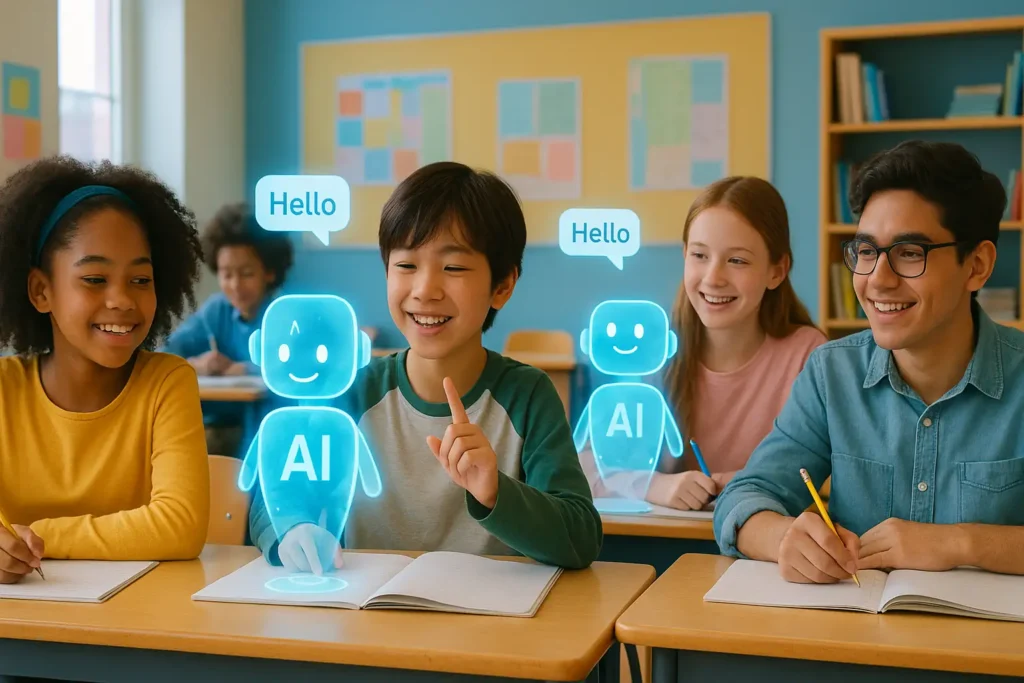Artificial Intelligence, or simply AI, is no longer a thing of the future—it’s part of our everyday lives. And when we talk about schools, learning, and teaching, AI has already begun to transform how we experience education. One of the most interesting ways this is happening is through the use of chatbots—those little digital helpers that can answer questions, give feedback, and even help students study.
In this article, we’ll have a friendly conversation about how chatbots and AI are being used in education, why they matter, and how they can make the lives of teachers and students easier. No complicated words. Just simple, clear examples to help you understand how everything works.
How Are Chatbots and AI Changing Education?
Right at the start, let’s clarify one thing: The Role of Chatbots and AI in Education isn’t about replacing teachers. It’s about helping them. AI and chatbots can support educators in many ways, especially by saving time and making learning more personalized and fun for students.
Imagine a chatbot as a super patient assistant. One that’s available 24/7 and never gets tired of answering the same questions. Whether a student is asking for help with homework or trying to understand a difficult topic, the chatbot can jump in and provide the answer. This helps students feel more confident and less frustrated.
Here are a few examples of how AI and chatbots are being used today:
- Homework Help: Platforms like Brainly and Quizlet (https://quizlet.com) use AI to help students find answers and explanations.
- Virtual Tutors: Tools like Khan Academy’s AI tutor or Duolingo use AI to create learning paths based on each student’s needs.
- Administrative Support: Chatbots can answer common school questions like “What time does school start?” or “When is the next test?”
Benefits of Using Chatbots and AI in the Classroom
Let’s break down the main benefits in a way that makes sense for everyday life:
1. More Personalized Learning
Every student learns at their own pace. Some get it quickly; others need more time. AI tools can adapt to each student, offering the right challenges or help. That means no one is left behind.
👉 Discover how AI in education supports personalized learning with ChatGPT and Gemini. Simple tips and real classroom examples.
2. Time Saver for Teachers
Teachers often spend hours correcting homework, answering the same questions, and planning lessons. AI can handle the repetitive tasks, freeing up teachers to do what really matters: teach and connect with their students.
3. Better Feedback
With AI, students can get instant feedback. No more waiting days to find out if an answer was right or wrong. This helps them learn faster and correct mistakes immediately.
4. More Accessible Learning
AI-powered tools can help students with disabilities by turning text into speech, reading aloud, or providing visual support. Learning becomes more inclusive.
Challenges and Concerns: Is Everything Perfect?
Of course not. While AI is amazing, we need to be careful.
- Privacy: When using AI, schools must ensure that student data is safe. It’s important to follow laws like the LGPD (Brazil’s version of GDPR) to protect personal information.
- Overuse of Technology: We still need human contact. Teachers bring warmth, encouragement, and inspiration—something machines can’t do.
- Understanding Limitations: AI can’t replace a teacher’s experience or emotional intelligence. It’s a tool, not a solution to everything.
Real Examples Teachers Can Use Today
You might be wondering, “Okay, but how can I use this in my classroom?” Great question! Here are a few practical ideas:
- Use ChatGPT to brainstorm lesson plans or generate quick quizzes.
- Try Microsoft’s Reading Progress tool, which helps assess reading fluency automatically.
- Integrate chatbots in messaging apps (like WhatsApp) to send reminders or answer students’ questions outside school hours.
- Use tools like Socratic (by Google) to help students find answers and explanations using AI.
These are just some ways you can start experimenting without needing to be a tech expert.
What Do Students Think?
Many students love using AI because it feels like having a tutor at home. It’s there when they need it, and it doesn’t judge. But some students also say they miss the human connection. That’s why it’s important to mix AI with teacher interaction—to get the best of both worlds.
What About the Future?

The future looks exciting! Here’s what might be coming:
- AI-powered grading systems that analyze student work in seconds.
- Smart classrooms that adapt lighting and sound based on students’ needs.
- Chatbots that understand emotions, helping students feel heard and supported.
But with these new possibilities comes responsibility. Teachers, parents, and schools must learn together, stay updated, and make sure technology is used wisely.
Key Points About The Role of Chatbots and AI in Education
- AI and chatbots help teachers by saving time and giving personalized support to students.
- Tools like ChatGPT, Quizlet, and Socratic already offer real classroom value.
- Feedback is faster, and learning can be more inclusive and fun.
- We must protect student data and avoid relying too much on machines.
- The goal is to use AI as a partner, not a replacement.
Conclusion
We’ve seen how chatbots and AI in education are changing the way we teach and learn. From helping with homework to supporting teachers with their daily tasks, AI brings many benefits. But we also need to be careful—using it wisely, with respect for privacy and a strong human touch.
By understanding how AI works and trying out simple tools, teachers can make their classrooms more dynamic and efficient. And most importantly, we can help every student learn in a way that fits their needs.
What do you think? Have you tried any AI tools in your classroom? Let’s chat in the comments below!

